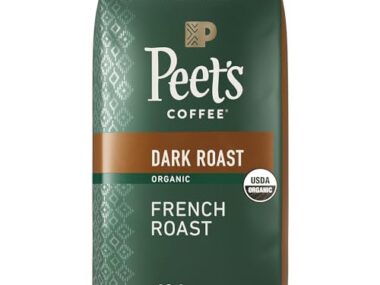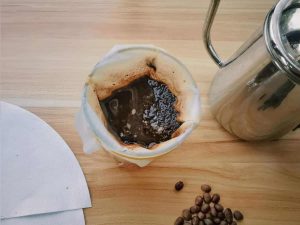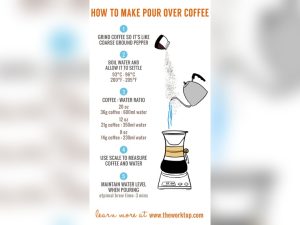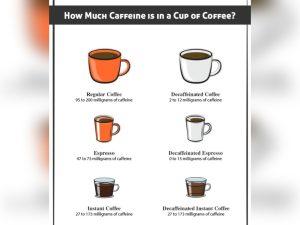Are you curious about how much caffeine is packed into your espresso coffee? Whether you rely on that quick shot to jumpstart your morning or enjoy it as a midday pick-me-up, knowing the caffeine content can help you make smarter choices for your energy and health.
You might think espresso has more caffeine than regular coffee because it’s stronger and bolder, but the truth might surprise you. Keep reading to discover exactly how much caffeine is in a shot of espresso, how it compares to your favorite brewed coffee, and what it means for your daily caffeine limit.
This knowledge will empower you to enjoy your espresso with confidence and control.
Espresso Caffeine Content
Espresso coffee is popular for its strong flavor and quick energy boost. Its caffeine content is a key reason many people enjoy it. Understanding how much caffeine is in espresso helps you manage your intake better.
This section breaks down the typical caffeine in one shot, how serving size changes caffeine amounts, and the difference a double shot makes.
Typical Caffeine In One Shot
A single shot of espresso usually contains around 63 milligrams of caffeine. This amount can vary slightly depending on the coffee bean type and roast. On average, this dose is enough to give you a quick alertness boost.
Espresso is more concentrated than regular coffee, so the caffeine is packed into a smaller volume. This makes it a strong choice for those wanting caffeine fast.
Variations By Serving Size
Serving size affects caffeine content a lot. A standard espresso shot is about one ounce. Some cafes serve smaller or larger shots, which changes caffeine levels.
For example, a ristretto shot is shorter and has slightly less caffeine. A lungo shot is longer and has more caffeine, but is less intense in flavor. Knowing serving size helps estimate caffeine intake accurately.
Double Shot Differences
A double shot of espresso contains roughly twice the caffeine of a single shot. That means about 125 milligrams of caffeine in two ounces. This amount can fuel longer focus and energy.
Many espresso drinks like lattes or cappuccinos use double shots. If you want more caffeine, choose a double shot, but be mindful of the total caffeine you consume daily.

Credit: cliffandpebble.com
Espresso Vs Regular Coffee
Espresso and regular coffee differ in taste, preparation, and caffeine content. Many people believe espresso has more caffeine. The truth depends on how you measure and brew each type. Understanding these differences helps you choose the right drink for your caffeine needs.
Caffeine Comparison By Volume
Espresso contains about 63 milligrams of caffeine per one-ounce shot. Regular coffee has roughly 95 milligrams per eight-ounce cup. Espresso is stronger per ounce, but regular coffee has more caffeine overall due to larger serving size. Comparing equal volumes, espresso delivers more caffeine.
Impact Of Brewing Methods
Espresso uses high pressure to extract coffee quickly. This method pulls more caffeine into a small shot. Regular coffee brews slowly with hot water, extracting caffeine over time. Brewing time and temperature affect caffeine levels in the final cup. These methods create different caffeine profiles in each drink.
Common Misconceptions
Many think espresso always has more caffeine than regular coffee. Serving size matters most for caffeine intake. Drinking a full cup of drip coffee gives more caffeine than a single espresso shot. Espresso’s intense flavor can trick the mind into thinking it has more caffeine. Knowing facts helps avoid confusion about caffeine content.
Factors Affecting Caffeine Levels
The caffeine content in espresso coffee changes due to several factors. These elements influence how much caffeine ends up in each shot. Understanding these can help you enjoy espresso better. They also explain why caffeine levels vary in different espresso servings.
Bean Type And Roast Level
The type of coffee bean affects caffeine amount. Arabica beans usually have less caffeine than Robusta beans. The roast level also matters. Light roasts keep more caffeine, while dark roasts lose some during roasting. So, choosing the bean and roast level changes caffeine strength.
Grind Size And Extraction Time
Grind size controls how fast water passes through coffee. Fine grinds slow water, allowing more caffeine to extract. Coarser grinds let water flow quickly, reducing caffeine extraction. Extraction time plays a role too. Longer brewing means more caffeine dissolves into the espresso.
Serving Temperature
Temperature impacts caffeine extraction during brewing. Hotter water extracts caffeine faster and more completely. Lower temperatures may leave some caffeine in the grounds. Serving temperature also affects how caffeine feels in your mouth. Warmer espresso can taste stronger and more bitter.
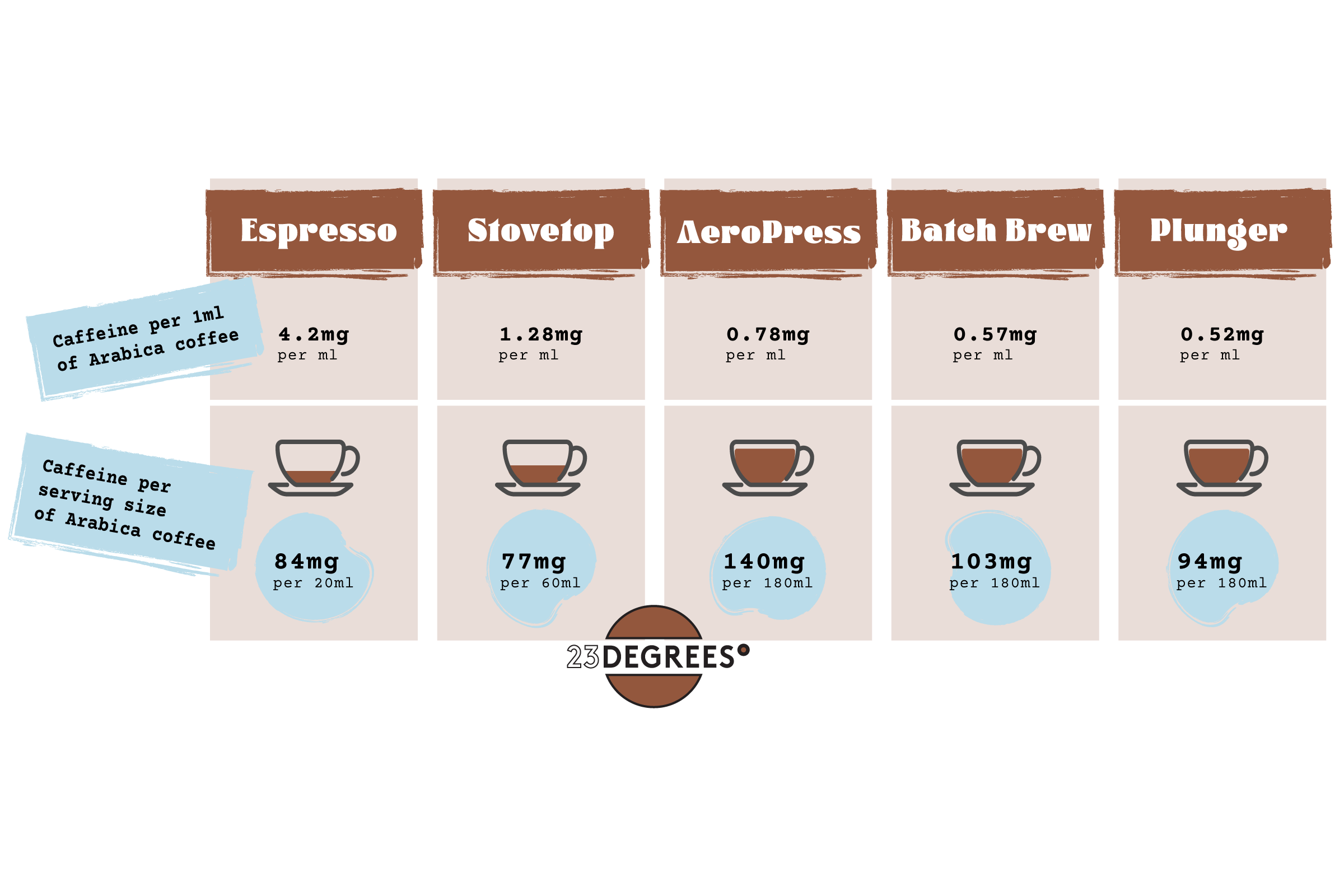
Credit: www.23degrees.com.au
Health Impacts Of Espresso Caffeine
Espresso coffee contains a concentrated amount of caffeine, which can affect your body in many ways. Understanding these health impacts helps you enjoy espresso safely. Caffeine in espresso can boost energy but also cause side effects. Some people wonder if espresso is healthier than other coffee types. Let’s explore these points.
Energy Boost And Alertness
Caffeine in espresso quickly stimulates the brain. It improves focus and reduces tiredness. One shot of espresso has about 64 mg of caffeine. This amount is enough to increase alertness and mental sharpness. Many drink espresso to stay awake during work or study. The effect usually starts within minutes and lasts a few hours.
Potential Side Effects
Too much caffeine can cause jitters and anxiety. Some people feel their heart race or get headaches. Espresso’s strong caffeine dose may upset the stomach or cause insomnia. People sensitive to caffeine should limit their intake. Drinking espresso late in the day may disturb sleep. It is best to watch how your body reacts.
Is Espresso Healthier?
Espresso has less caffeine per serving than a cup of drip coffee. It also contains antioxidants that support good health. The short brewing time preserves many natural compounds. Unlike sugary coffee drinks, plain espresso has no added calories. This makes it a good choice for those watching weight. Drinking espresso in moderation fits a healthy lifestyle.
Espresso Caffeine At Popular Chains
Espresso caffeine content varies across popular coffee chains. Each brand has its own espresso shot size and caffeine level. Knowing these differences helps you choose your perfect caffeine boost.
Starbucks Espresso Shots
Starbucks espresso shots contain about 75 mg of caffeine each. This is higher than the average espresso shot at many other places. Their espresso is made from a dark roast blend. Starbucks uses 1-ounce shots for their espresso. This means you get a stronger caffeine kick per shot. Many espresso drinks like lattes or macchiatos use one or two shots. Two shots double the caffeine to around 150 mg. This makes Starbucks espresso a popular choice for a powerful energy lift.
Other Coffee Shop Variations
Other coffee shops often serve espresso with 40 to 65 mg of caffeine per shot. These shots are usually smaller, about 0.75 ounces. The caffeine content depends on the coffee bean type and roast level. Some shops use light or medium roasts, which have different caffeine amounts. Single-origin beans can also vary the caffeine slightly. Independent cafes may offer stronger or weaker espresso based on their recipe. This variety lets you find an espresso that fits your taste and caffeine needs.
Measuring And Testing Caffeine
Measuring and testing caffeine in espresso coffee is important to understand how much stimulant you consume. Caffeine content can vary by factors like bean type, roast level, and brewing method. Accurate testing helps clarify these differences. It also guides consumers who monitor their caffeine intake closely.
Laboratory Results
Laboratories use precise methods to measure caffeine in espresso. High-performance liquid chromatography (HPLC) is common. This technique separates and quantifies caffeine molecules. Tests show espresso shots often contain 63 to 75 mg of caffeine on average. Variations depend on coffee origin and extraction time. Lab results provide reliable data for research and quality control.
Home Testing Tips
Home testing of caffeine is less precise but still possible. Some kits use color change or test strips to detect caffeine presence. These kits do not measure exact caffeine amounts but confirm if caffeine is there. Another way is comparing effects on alertness after drinking espresso. Keeping consistent brewing methods helps estimate caffeine levels at home. Recording caffeine effects can guide personal consumption limits.

Credit: www.coffeeness.de
Frequently Asked Questions
How Much Caffeine Is In A Shot Of Espresso?
A single shot of espresso contains about 63 milligrams of caffeine. This amount can vary slightly by brand and preparation.
Does Espresso Coffee Have More Caffeine Than Normal Coffee?
Espresso has more caffeine per ounce than regular coffee. One shot contains about 64 mg caffeine, while an 8 oz cup has 95 mg.
Is 2 Shots Of Espresso A Lot?
Two shots of espresso contain about 120-150 mg of caffeine, a moderate amount for most adults. This equals roughly one strong coffee. Drinking two shots is common and generally safe unless sensitive to caffeine.
Is Espresso Healthier Than Coffee?
Espresso and regular coffee offer similar health benefits. Espresso has more caffeine per ounce but less per serving. Both contain antioxidants and can boost metabolism. Choose based on preference, not health differences.
Conclusion
Espresso packs a strong caffeine punch in a small cup. A single shot has about 63 mg of caffeine. This is less than a regular coffee cup but more caffeine per ounce. Knowing this helps you choose your drink wisely.
Enjoy your espresso, but watch your total caffeine intake daily. Balance and moderation keep your coffee moments enjoyable and safe.




